Contents
- 1. Mona Lisa by Leonardo da Vinci (Denon Wing, Room 711)
- 2. Les Noces de Cana by Véronèse (Denon Wing, Room 711)
- 3. Vénus de Milo (Sully Wing, Room 345)
- 4. Victoire de Samothrace (Denon Wing, Room 703)
- 5. Le Sacre de l’Empereur Napoléon Ier by Jacques-Louis David (Denon Wing, Room 702)
- 6. La Liberté Guidant le Peuple (Denon Wing, Room 700)
- 7. Psyché Ranimée par le Baiser de l’Amour by Antonio Canova (Denon Wing, Room 403)
- 8. Louis XIV by Hyacinthe Rigaud (Sully Wing, Room 916)
- 9. La Dentellière by Jan Vermeer (Richelieu Wing, Room 837)
- 10. Chevaux de Marly (Richelieu Wing, Cour Marly)
- 11. Le Couronnement de la Vierge (Denon Wing, Room 708)
- 12. Le Tricheur à l’As de Carreau by Georges de La Tour (Sully Wing, Room 912)
- 13. Portrait of the Artist Holding a Thistle by Albrecht Dürer (Richelieu Wing, Room 101)
- 14. Captif Sculptures by Michelangelo (Denon Wing, Room 403)
- 15. French Crown Jewels (Galerie d’Apollon)
- Exploring the Louvre Palace
- The Grand Entrance: Pyramid du Louvre
- The Medieval Louvre: Foundations of the Palace
- A Magnificent Royal Palace Fit for the Kings of France
- Where to Stay near the Louvre Museum in Paris
- How to Make the Most of Your Visit to the Louvre Museum
A tour through the Louvre Museum’s extensive galleries provides a crash course in Western Civilization’s finest art. Some of the world’s most famous masterpieces are on display here, including the Mona Lisa by Leonardo da Vinci and the Vénus de Milo.
A large number of the museum’s paintings were owned by the various kings who lived in the Louvre when it was a royal residence; other pieces were acquired through France’s treaties with the Vatican and the Venetian Republic. The collection was further enriched by the spoils of Napoléon I.
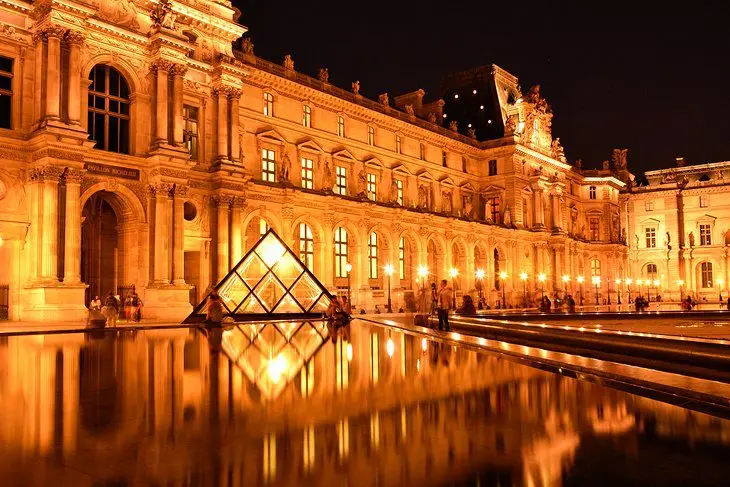
The world’s largest museum, the Musée du Louvre packs thousands of artworks into a 73,000-square-meter exhibition space in three sections: the Denon, Richelieu, and Sully wings, in a magnificent building that was once the palace of French kings.
Each wing has more than 70 rooms displaying paintings and objects of art, plus there are enormous halls filled with sculptures. It’s impossible to see the entire collection in one day or even in a week.
Visiting the Louvre is one of the essential things to do in Paris. However, most tourists need some guidance to really appreciate the art and its rich cultural heritage. This checklist of 15 Louvre “highlights” includes historical context and in-depth insights about each piece to enhance your experience.
1. Mona Lisa by Leonardo da Vinci (Denon Wing, Room 711)
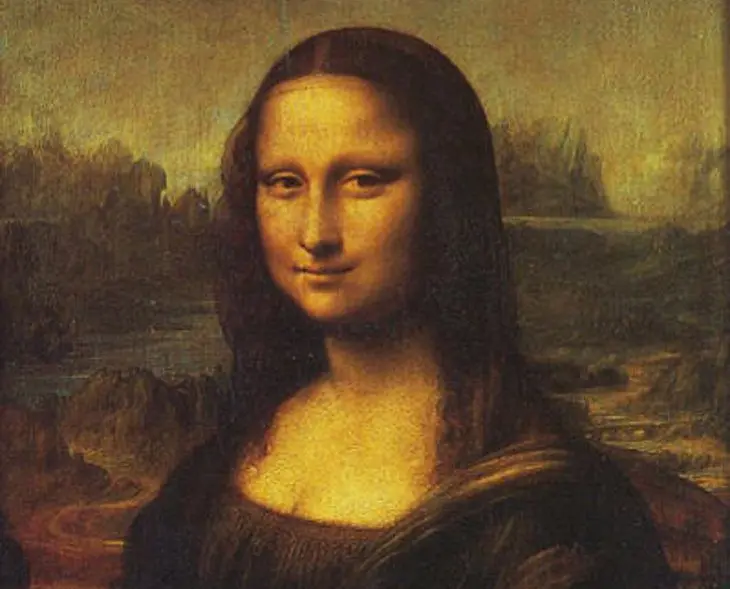
Scholars debate what makes the Mona Lisa one of the most renowned paintings in the world. One explanation is the sense of mystery.
Although the identity of the sitter is unclear, the woman portrayed is thought to be Lisa Gherardini, wife of Francesco del Giocondo (a silk merchant in Florence, Italy). For this reason, the painting’s Italian name is La Gioconda, which translates to La Joconde in French.
Another explanation for the painting’s celebrity is the subject’s enigmatic smile, possibly symbolizing the ideal of happiness. Her captivating expression and sidewards glance have a way of enchanting viewers. Observers notice how the Mona Lisa appears to be watching them from wherever they stand in the room.
Many visitors come to the Louvre just to see this one painting, certainly the museum’s most famous work of art. Created by Leonardo da Vinci around 1503, the small painting in the Salle des États (Room 711) is covered with an extra layer of plexiglass and is usually surrounded by a crowd of tourists trying to a get a glimpse of it.
To gain a better appreciation of this painting, it’s a good idea to take a small-group walking tour of the Louvre led by a knowledgable guide. This three-hour tour allows participants to skip the museum’s long entrance lines and head straight to the must-see works, making the most of the time spent at the museum.
2. Les Noces de Cana by Véronèse (Denon Wing, Room 711)
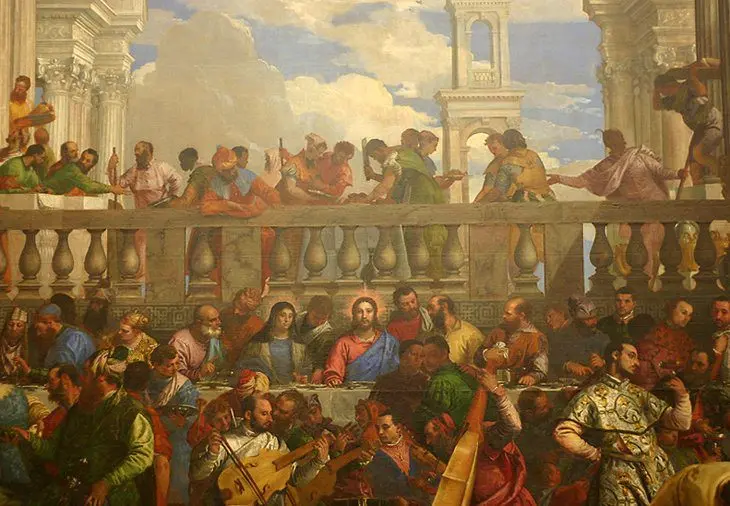
Paolo Caliari (known as Véronèse) created Les Noces de Cana in 1563, commissioned by the Benedictine San Giorgio Maggiore Monastery in Venice.
The Louvre Museum’s largest painting, this immense six-meter-tall by 10-meter-wide canvas covers an entire wall of the Louvre gallery from floor to ceiling. Originally, it was intended to decorate the refectory of the Venetian monastery.
Les Noces de Cana (The Wedding Feast at Cana) is a masterful composition that portrays the biblical wedding scene at Cana in the Galilee, the event according to John the Apostle when Christ performs the miracle of turning water into wine.
The remarkable composition of more than 100 figures somehow manages to look harmonious rather than crowded. The bride and groom are seated at the end of the banquet table on the left-hand side. Christ is at the center surrounded by his disciples. Contemporary Venetians mingle with biblical personages in Oriental turbans.
The artist’s astounding attention to detail is seen in the realistic minutia, such as the draping of the splendid Venetian costumes. The action-packed scene is full of surprises: a dwarf holding a parakeet (lower lefthand side), little birds, friendly dogs, and an amusing cat (lower righthand side) that seems to be an uninvited guest as it scratches its claws on a water pitcher.
3. Vénus de Milo (Sully Wing, Room 345)
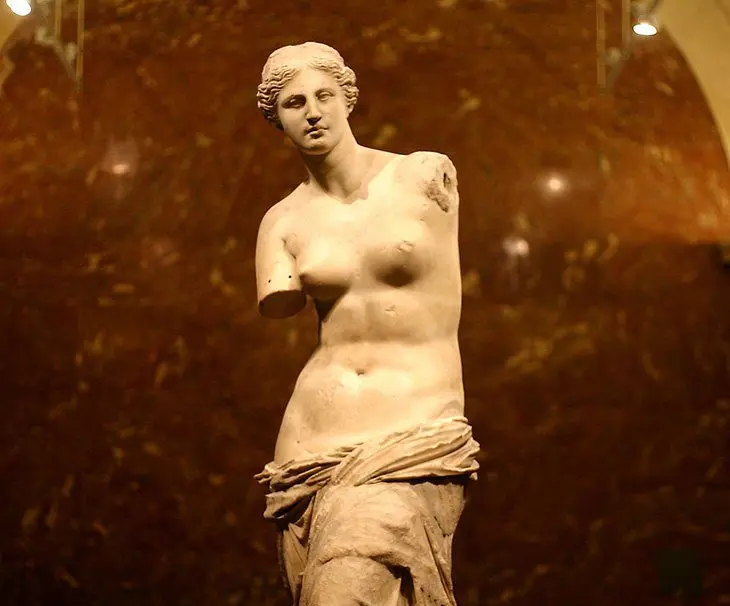
The Vénus de Milo stands in the Louvre’s Galerie des Antiques, in the Salle de la Vénus de Milo (Room 345), a sumptuous 19th-century gallery that is clad in red marble.
This alluring statue, also known as Aphrodite, represents the Greek ideal of beauty. Created around 100 BC, the goddess statue reflects the stylization of the late Hellenistic Period.
The work has mesmerized the art world ever since it was discovered on Greece’s Island of Milos (“Melos” in ancient Greek) in 1820 and was presented to Louis XVIII.
What makes this statue a masterwork is the balanced composition, the sense of space, and the way the drapery falls over the goddess’ hips. Unfortunately the missing pieces of marble make it difficult to fully identify and understand the statue.
Art historians have tried to imagine how her arms were positioned and where she might have been standing. Some believe that she may have held an apple, a crown, or a shield. Another hypothesis is that Venus held a mirror in one hand to admire her reflection.
4. Victoire de Samothrace (Denon Wing, Room 703)
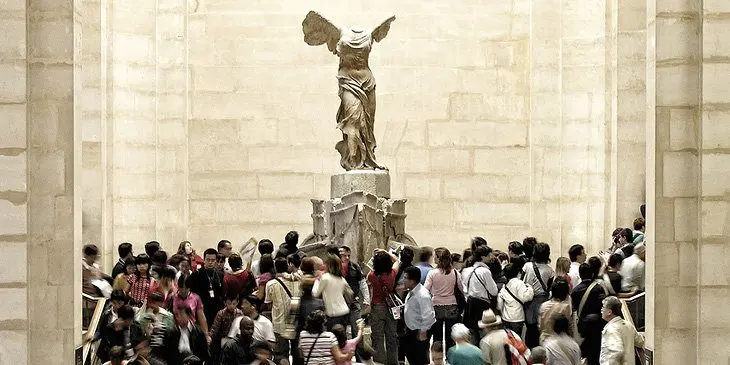
A masterpiece of Hellenistic art, this monumental classical sculpture is breathtaking to behold. Presented in its own space at the top of the grand Daru Staircase, the Victoire de Samothrace (Winged Victory) has a way of captivating visitors when they turn the corner and catch a glimpse of the statue.
Perched in a courageous stance on the prow of a ship, the winged Goddess of Victory (Nike) leads a vessel sailing through heady gusts of wind. Created around 190 BC, the winged Goddess of Victory was found on the island of Samothrace and is thought to be a religious offering by the people of Rhodes in commemoration of a naval victory.
The figure of the Goddess is portrayed so accurately that one can hardly believe it was crafted 2,000 years before photography and 3D graphic modeling. The spiraling composition creates the effect of vigorous movement, with the wings held back and the right leg placed in front of the left.
Thanks to the subtly rendered sculptural details, the Goddess appears to be drenched in water. Her clothing is given the realistic effect of light fabric that clings to her hips and legs, revealing the shape of the nude female body. At the same time, a breeze causes the goddess’ draped tunic to billow, which lends a stunning sense of realism.
5. Le Sacre de l’Empereur Napoléon Ier by Jacques-Louis David (Denon Wing, Room 702)
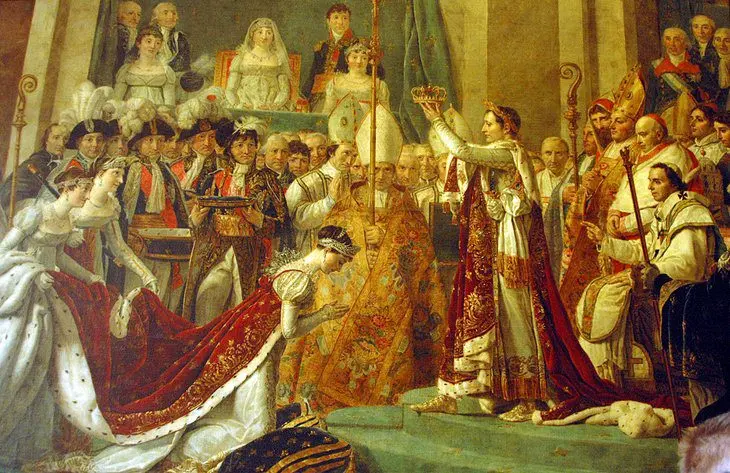
Napoléon I commissioned Jacques-Louis David to create this majestic painting as a document of his coronation ceremony. Napoléon proclaimed himself Emperor in May 1804 after a coup d’état following his victorious military campaigns in Italy and Egypt.
The coronation ceremony was conducted according to the protocol of crowning a king in the French monarchic tradition. However Napoléon crowned himself while facing the congregation instead of being crowned by the Pope, to make a statement about his independence from the church.
Jacques-Louis David attended the coronation ceremony of December 2, 1804 at the Notre-Dame Cathedral in Paris. From 1805 to 1808, the artist created this impeccably detailed and lifelike painting of the event complete with 146 people in attendance.
The Coronation of Empereur Napoléon I spans an oversized six-meter by 10-meter canvas; its grand proportions give viewers the impression of actually being present at the coronation ceremony. Upon viewing the painting, Napoléon is said to have made a statement in reference to its grandeur and realism: “One can walk through this painting!”
David depicts the ceremony accurately while complying with Napoléon’s request to convey a symbolic and political message, glorifying the event to give it a unique place in history.
Les Salles Rouges (Red Rooms) display The Coronation of Empereur Napoléon I and other prestigious historical paintings, such as Madame Récamier by Jacques-Louis David, Le Radeau de la Méduse (The Raft of the Medusa) by Théodore Géricault, Mademoiselle Rivière by Jean-Auguste-Dominique Ingres, La Liberté Guidant le Peuple (Liberty Guiding the People), and La Mort de Sardanapale (Death of Sardanapalus) by Eugène Delacroix.
6. La Liberté Guidant le Peuple (Denon Wing, Room 700)
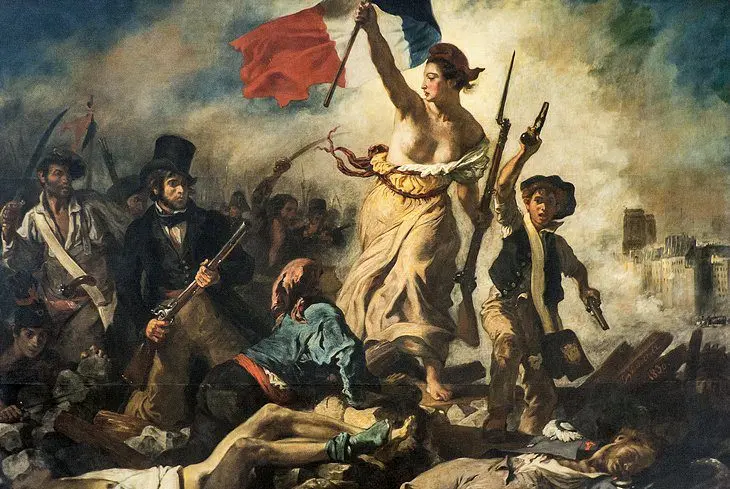
This evocative painting illustrates one of the most important events in French history, the Parisian uprising of July 1830, when the Republicans of France led a revolt against the government of the Second Constitution.
Delacroix intended La Liberté Guidant le Peuple (Liberty Guiding the People) to highlight the values of the Revolution of 1789 and the ideal of popular sovereignty. The creation of this piece was a patriotic act, as Delacroix believed passionately in the Republican cause.
The allegorical figure of Liberty is depicted as a strong and inspiring bare-breasted woman (nudity is commonplace in French historical paintings), suggesting lineage to a classical Greek goddess. Evidence of her determination and fighting spirit, she holds a French flag in one hand and an infantry gun in the other.
The figure of Liberty emerges victoriously from a dark, smoky background and appears to be bathed in light, symbolic of her moral illumination. Delacroix brings a deeply emotional, romantic interpretation to the painting and at the same time a realistic quality.
7. Psyché Ranimée par le Baiser de l’Amour by Antonio Canova (Denon Wing, Room 403)

Of all the sculptures in the sunlight-filled Galerie Michel-Ange (Room 403), this one is the most charmingly rendered. This sculpture, Psyche Revived by the Kiss of Love (also titled L’Amour et Psyché in French) was inspired by the mythological story of Cupid and Psyche from Ovid’s Metamorphoses.
In this story, Cupid sees Psyche who has fallen into a spell of sleep after breathing in a forbidden potion. Cupid gently approaches Psyche, about to kiss her. Then Psyche wakes up and languidly embraces Cupid. This is the tender moment captured in this enchanting masterpiece.
Antonio Canova created a piece that is full of emotion, typical of Romantic Neoclassical sculpture. At the same time, the sculpture is so precise that the figures seem lifelike.
Notice the fine sculpting of Cupid’s wings, the quiver full of arrows, and the ornamentation on the amphora. Admire the way Cupid holds Psyche’s neck and the curve of her hip as she turns to embrace him, all shown with a perfect sense of proportion and movement.
Meticulously chiseled features and anatomical details like Psyche’s belly button and graceful toes add a sense of authenticity, creating an impression that the figures are made of flesh rather than marble.
8. Louis XIV by Hyacinthe Rigaud (Sully Wing, Room 916)
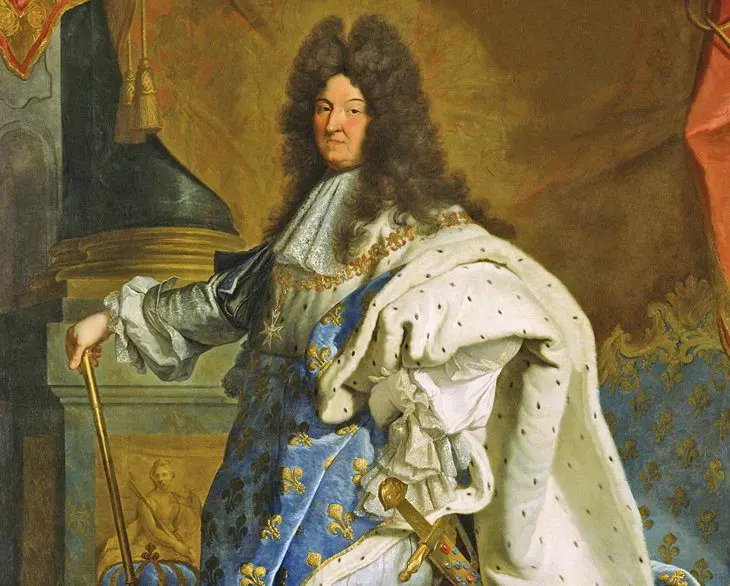
This emblematic painting of the “Sun King” was created in 1701 by the French royal portrait artist Hyacinthe Rigaud. The painting was originally intended to be a gift for Philip V of Spain, however the French Court liked it so much, the painting was never sent to the Spanish King.
Rendered in exquisite detail, the portrait represents Louis XIV as the ultimate image of absolute power. The opulent background and the King’s impressive coronation robes symbolize his greatness. Louis XIV was 63 years old when this portrait was painted.
Notice the richness of the king’s robe, which is embroidered with fleurs-de-lys (lily flowers), the royal symbol. In the background, a crown rests beside the king on a stool. This painting was designed to remind the viewer of Louis XIV’s authority.
9. La Dentellière by Jan Vermeer (Richelieu Wing, Room 837)
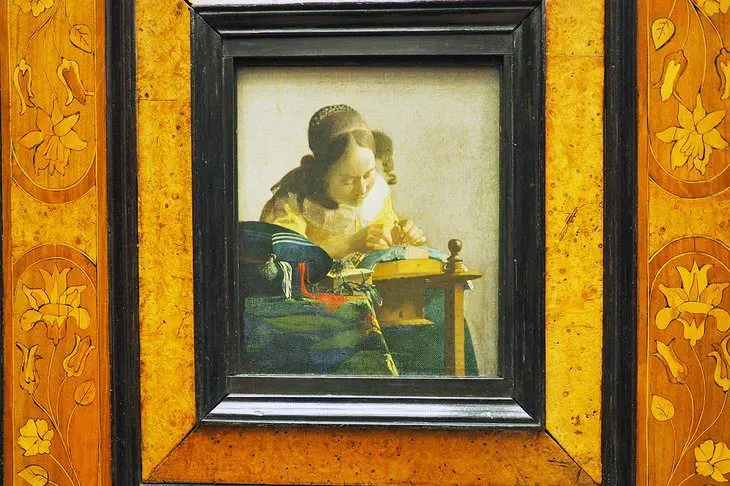
Renoir considered Jan Vermeer’s painting of The Lacemaker to be one of the most beautiful paintings in the world. La Dentellière was created by Vermeer around 1669 or 1670.
The motif of lace was often used in 17th-century Dutch paintings to symbolize traditional female virtues. In the forefront of the painting is a little book that is most likely a Bible, which gives the piece another layer of moral and religious suggestion.
Vermeer loved to paint scenes of everyday life and was skilled at depicting familiar objects in an appealing way. The young woman (most likely Vermeer’s wife) is shown intently focused on her painstaking work of lacemaking.
The thread between the woman’s fingers and the pins and bobbin form the central focal point of the piece. The objects become more blurred in the background, mimicking the human eye’s natural optical field.
Vincent van Gogh praised this painting for its harmonious blend of colors, seen in the vibrant sewing cushion and multi-hued yarns.
10. Chevaux de Marly (Richelieu Wing, Cour Marly)
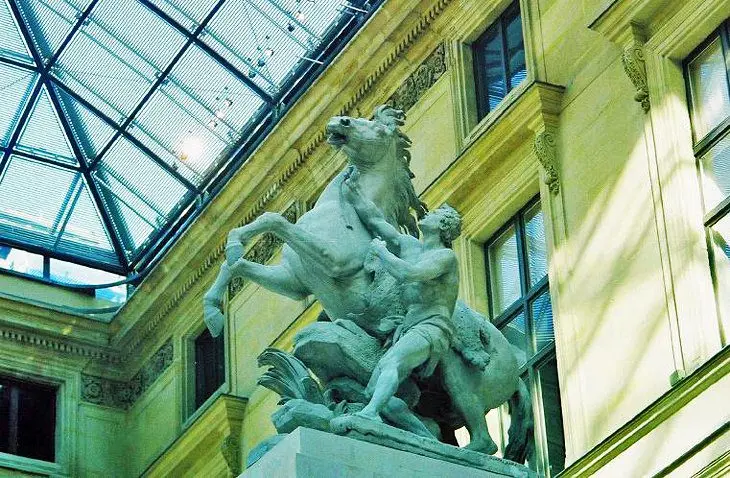
The Chevaux de Marly (Marly Horses) was commissioned by King Louis XIV for the Château de Marly horse pond. Created between 1739 and 1745, this monumental Carrara marble sculpture is a larger-than-life image of two horses restrained by grooms.
The sculptor, Guillame Coustou, was likely inspired by the ancient Roman statues found in front of the Quirinal Palace in Rome, which show demigods Castor and Pollux endeavoring to tame their horses. Alluding to this classical reference, the Marly Horses symbolize the struggle between man and nature (represented by an untamed horse).
11. Le Couronnement de la Vierge (Denon Wing, Room 708)
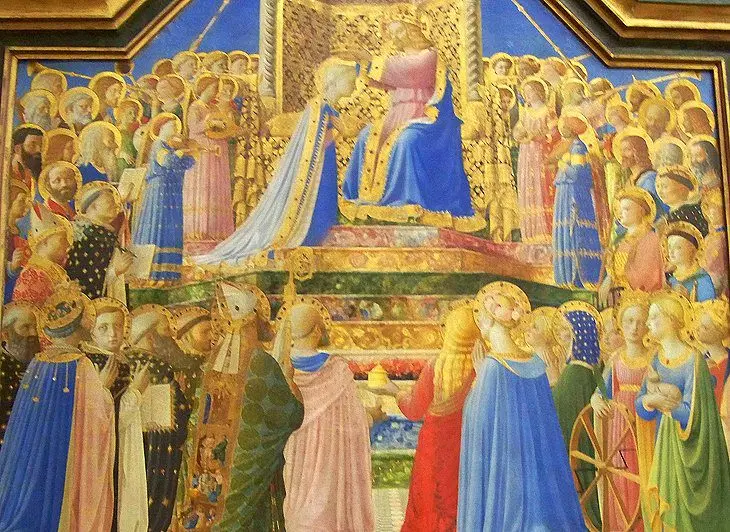
Displayed in the Louvre’s lovely Salon Carré (Room 708), the Coronation of the Virgin is one of the Louvre’s masterpieces of medieval painting. Guido di Pietro, known as Fra Angelico, created this work from 1430 to 1432 and it was originally used as an altarpiece for the convent of San Domenico in Fiesole outside Florence.
The theme of the Coronation of the Virgin was very commonly represented in art during the 13th century, and this example shows exceptional delicacy and artistic brilliance.
The sumptuous painting illustrates the Assumption of the Virgin Mary as she is welcomed into heaven and crowned by Christ, who is shown seated high above the multitude of onlookers on a throne accessed by marble steps.
The scene is rendered with incredible detail and in luminous hues. For instance, Fra Angelico painted the nine steps of marble in different colors. An abundance of gilding is found throughout, in Christ’s throne, as well as the angels’ halos, which seems to suggest a royal court in heaven.
12. Le Tricheur à l’As de Carreau by Georges de La Tour (Sully Wing, Room 912)
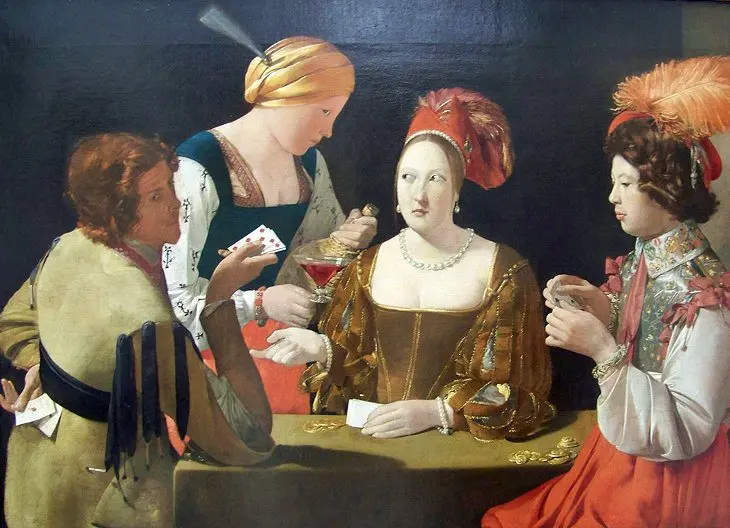
Created around 1635, The Cheat with the Ace of Diamonds finds a place of honor among France’s 17th-century Peintres de la Réalité (Painters of Reality). Georges de La Tour’s signature style of realism brings to life the scene of four people gathered around a table while playing cards.
The painting’s intricate details and subtle expression of emotions lend authenticity, allowing viewers to feel like spectators of a real card game. As spectators, we have a sense of curiosity and anticipation about what will happen next.
We watch as the subject of the painting, a flamboyantly dressed feather-capped young man, is about to be duped. In an unusual composition, the subject is depicted at the far right (rather than the center) of the painting, in a space apart from the others.
Meanwhile the other group of three people seem to share a secret, evidenced by their sidewards eye movements. The woman with the low-cut neckline draws the viewer’s attention with her sneaky glance. She is silently communicating with the player (the cheat) on the left side of the painting who discreetly pulls an ace of diamonds card from under his belt, which will be the “winning” card.
An intriguing aspect of this painting: The cheat appears to peer out towards the viewer, as if he knows he’s being observed. As viewers, we catch the cheat and his cohorts in their act of wrong-doing. George de La Tour uses this scene to tell us a moral drama about the sins of lust, liquor, and gambling.
13. Portrait of the Artist Holding a Thistle by Albrecht Dürer (Richelieu Wing, Room 101)
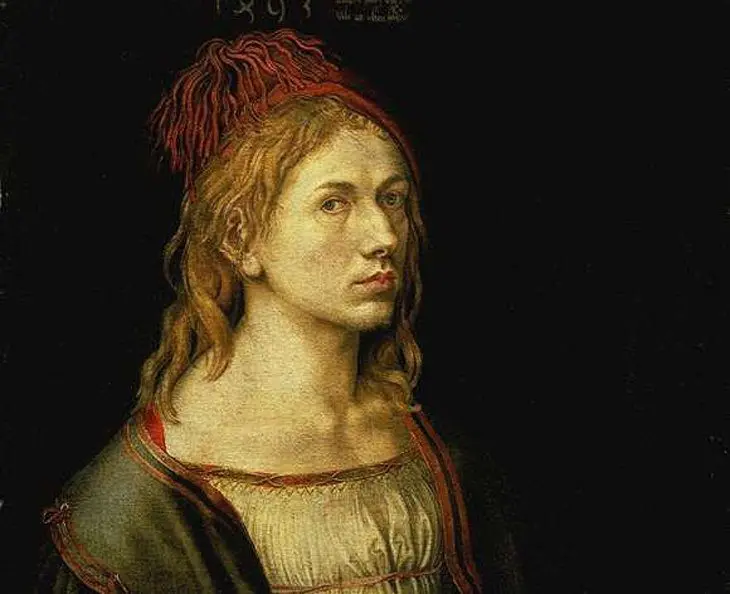
A striking painting, the Portrait de l’Artiste Tenant un Chardon was one of the first stand-alone self-portraits in European painting. Albrecht Dürer created this portrait of himself in 1493 when he was only twenty-two years old. The artist is holding a thistle, which either represents fidelity to his fiancée or an allusion to Christ’s Passion.
The composition of a three-quarter length bust was typical of portrait painting in the 16th century. Viewers can detect some awkwardness in the portrait, because the artist was working from his reflection in the mirror.
14. Captif Sculptures by Michelangelo (Denon Wing, Room 403)
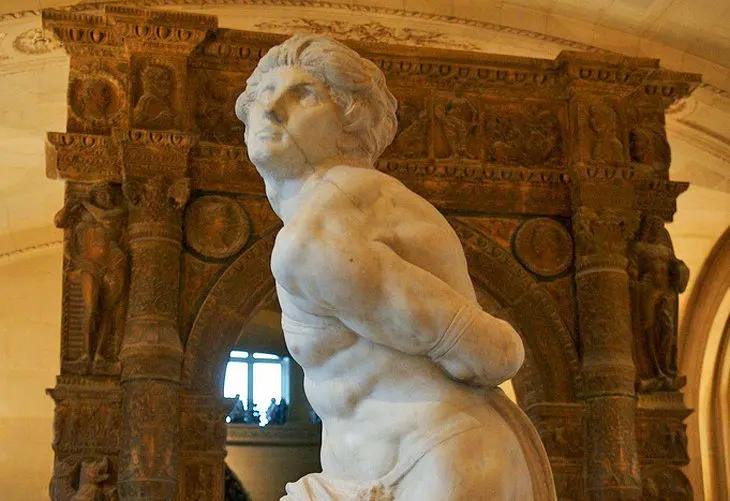
These expressive statues are masterworks by Michelangelo, showing his genius of technical ability and emotional depth. The pair of sculptures, L’Esclave Mourant (The Dying Slave) and the L’Esclave Rebelle (The Rebellious Slave), stands in the Galerie Michel-Ange (Room 403), a spacious gallery with large windows that allow natural light to brighten the space.
Both are chained and shown in the nude to emphasize their vulnerability, but the two slaves convey very different emotions. The Dying Slave appears to be in a deep eternal sleep, while the Rebellious Slave is distorted in a violent struggle. Some art historians have interpreted the sculptures to symbolize the human soul that is shackled by the body.
Michelangelo began work on the statues in 1513 as part of a monumental project to create a tomb of Pope Julius II. However, the project was delayed and eventually discarded. This is one possible reason why the statues are unfinished, with chisel marks still visible.
Another explanation is that Michelangelo felt he had achieved the maximum artistic potential from the raw block of marble. In fact, there is something poetic about the image of slaves waiting to be liberated from the marble.
15. French Crown Jewels (Galerie d’Apollon)
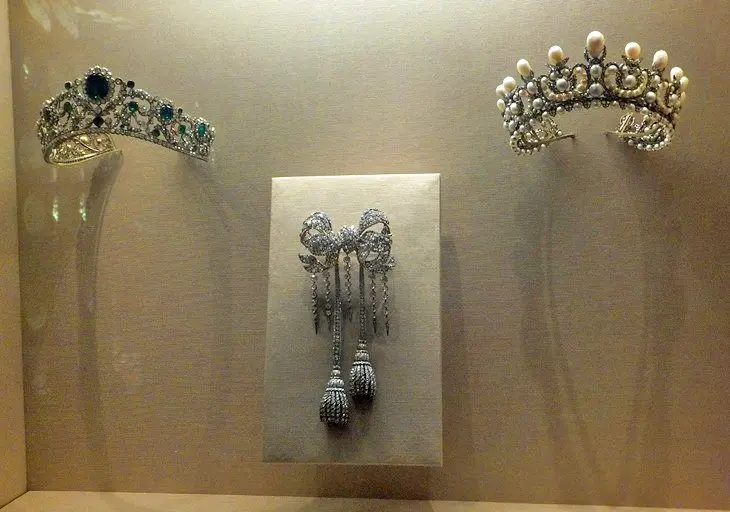
The ultimate symbol of grandeur and sovereignty, France’s coronation crowns reflected the wealth and power of the French monarchs, as well as the glory of Emperor Napoléon I and Napoléon III. The crowns were custom made for each king and embellished with precious jewels.
Be sure to see the Couronne de Louis XV (Crown of Louis XV), which features two rows of pearls and eight gems (emeralds, sapphires, rubies, and topazes) alternating with sparkling diamonds. The arches of the crown are decorated with diamond fleurs-de-lys (lily flowers), the emblem of French monarchs since the 12th century.
For those who like bling, the 140-carat “le Régent” (the “Regent” diamond) is not to be missed. This dazzling gem is one of the finest, most brilliant diamonds in the world, prized for its perfection.
A piece that belonged to the eldest daughter (and only surviving child) of Louis XVI and Marie-Antoinette, the Diadème de la Duchesse d’Angoulême (Duchesse of Angoulême’s Tiara) is a dazzling piece decorated with diamonds and emeralds.
The majestic Couronne de l’Impératrice Eugénie (Empress Eugénie’s Crown) exemplifies lavish Second Empire jewelry. Imperial jeweler Alexandre-Gabriel Lemonnier created this glittering crown with 2,480 diamonds set in the form of palmettes and flanked by 56 precious emeralds.
The crown jewels are displayed in the recently refurbished Galerie d’Apollon (Denon Wing, Room 705), which reopened in 2020. This extravagantly adorned gallery was created in the 17th century by Louis Le Vau, architect of the Château de Versailles, and Charles Le Brun, official painter to Louis XIV. The gallery’s splendid decor rivals the beauty of the gems held within the exhibits. In the 19th century, Eugène Delacroix completed the gallery’s central ceiling painting.
Exploring the Louvre Palace
The Grand Entrance: Pyramid du Louvre
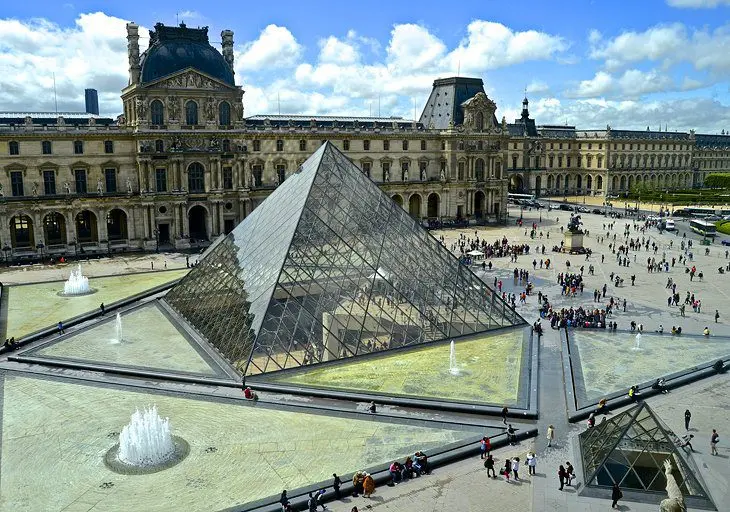
The main entrance to the Louvre is in the central courtyard at the Pyramid du Louvre. Designed by architect Ieoh Ming Pei and opened in 1989, this iconic 22-meter-high pyramid is constructed from 675 panes of glass, flooding the interior space with natural light.
The Pyramid allows access to the Cour Napoléon, where the ticket office and information desk are located.
There are quicker ways to enter the museum (from the Carrousel du Louvre or Rue de Rivoli entrance), but the Glass Pyramid is the most dramatic entrance to the Louvre’s fabulous collection of fine art.
The Medieval Louvre: Foundations of the Palace
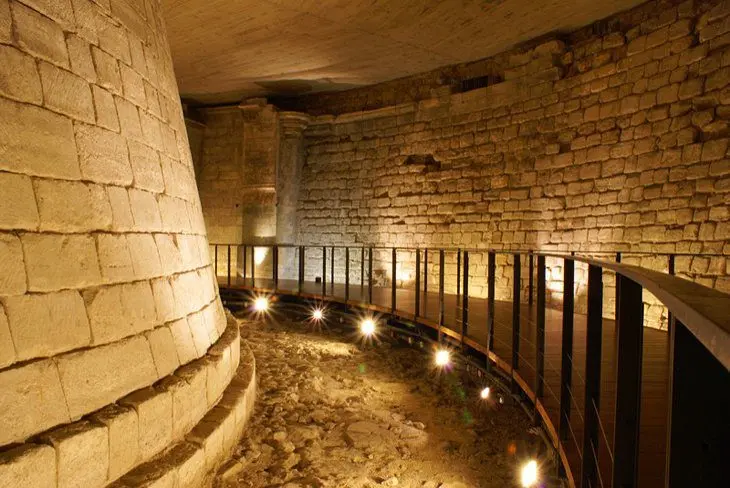
The original foundations of the Louvre are found in the Medieval Louvre section, entered through the Pyramid and the escalator to the Sully wing. This underground area reveals the medieval fortress that was created for King Philippe Auguste in 1190.
Visitors can see the ancient foundations, the remnants of the medieval moat, and the dungeons, as well as the Salle Saint-Louis (built between 1230 and 1240), the only remaining vestige of the medieval fortress’ main building.
Several rooms in the Medieval Louvre section display documents, models, and paintings related to the history of the Louvre.
A Magnificent Royal Palace Fit for the Kings of France

The Louvre’s somber medieval fortress was enhanced under Charles V, Charles VI, and Henri II, and transformed into a much more impressive and luxurious royal palace by Louis XIII and Louis XIV. The Salle des Caryatides is a grandiose reception hall created for King Henri II.
The Chambre de Parade du Roi (Room 25 of the Egyptian Antiquities department) is the bedroom where Charles IX and Henri III greeted the court every morning. The Salle des Sept-Cheminées (Room 74 of the Greek, Etruscan, and Roman Antiquities department) was the royal apartment of Louis XIV until he moved his palace to Versailles.
Even after the Louvre was no longer a royal palace, it was used for official purposes by Napoléon III. Visitors can also see the opulent Grand Salon and Dining Rooms of the Appartements Napoléon III (Richelieu Wing, Room 544). Exemplifying Second Empire style, the lavish decor features sparkling chandeliers, gilded moldings, decorative stucco work, silk curtains, velvet furnishings, and gorgeous ornately painted ceilings.
Another must-see room in the museum is the Galerie d’Apollon. This glorious reception hall has a spectacular ceiling painting that was begun by Charles Le Brun, paying homage to Louis XIV, the Sun King. The portion not completed by Le Brun, the breathtaking central panel depicting Apollo Slaying the Serpent Pythonwas painted by Delacroix in 1851.
Where to Stay near the Louvre Museum in Paris
The Musée du Louvre is found in the center of Paris in the 1st arrondissement, which is a convenient area for tourists to stay. We recommend these highly rated hotels within walking distance of the Louvre Museum:
- Mandarin Oriental Paris : This five-star hotel offers sumptuous accommodations and exceptional amenities: an upscale spa, peaceful garden, a well-equipped fitness center, several fine-dining restaurants, and a fancy pâtisserie shop. The location on the Rue Saint-Honoré is a short walk to the Jardin des Tuileries and to many haute-couture boutiques.
- Hôtel La Tamise – Esprit de France : Steps away from the Rue de Rivoli and the Jardin des Tuileries, this mid-range boutique hotel provides well-appointed rooms with comfortable beds. Amenities include a concierge, restaurant, and breakfast buffet.
- Hôtel Odyssey by Elegancia : Near the Jardin du Palais Royal and about a 10-minute walk to the Louvre, this three-star hotel has relatively affordable rates. The hotel’s compact guest rooms (best suited for solo travelers) feature trendy ultra-modern decor.
- Hôtel Opera Maintenon : This budget two-star hotel delivers an excellent value for the price. Nestled on a quiet street in a historic building, the hotel is within walking distance of the Louvre, the Opera House, and the Galeries Lafayette. Amenities include a 24-hour front desk, concierge, and a traditional French breakfast (for an additional charge).
How to Make the Most of Your Visit to the Louvre Museum
- Hours: The Louvre Museum is open Monday, Wednesday, Thursday, Friday, Saturday, and Sunday from 9am until 6pm. The latest entry is 5pm. The Louvre is closed on Tuesdays.
- Guided Tours: To make sure you see all the museum’s essential highlights, try the Skip the Line: Louvre Museum Walking Tour . This three-hour tour includes headsets, so that you can easily hear your guide explain the history and artistic significance of the museum’s masterpieces, from its priceless paintings to the crown jewels.
- Tickets: The main entrance and ticket office is at the Pyramid du Louvre, but this also has the longest lines. Entrances at the Carrousel du Louvre from the Métro station or the Porte des Lions avoid the long lines. You can buy tickets in advance, but you must pick them up in person at the Glass Pyramid entrance (this does not allow you to skip the lines).
- Paris Museum Pass: The Paris Museum Pass allows unlimited, free admission to the Louvre Museum, as well as over 50 other museums and monuments. Visitors can choose a 2-day pass or a 4-day pass , depending on the length of their stay in Paris. With this pass, you can skip the entry line at the Louvre.
- Resources: The Louvre website also has a section devoted to practical information about the museum’s hours of admission, room closures, and amenities.
- Food and Drink: The Louvre has over a dozen options (cafés, restaurants, and snack bars) for visitors in search of refreshments. The Café Richelieu treats guests to a refined menu and decadent hot chocolate supplied by the legendary Angelina tearoom. In an elegant pavilion of the Denon wing near the French paintings gallery, Le Café Mollien serves a simple lunch menu. The most picturesque setting is found at the open-air Terrasse de Pomone, a fashionable crêperie and brasserie in the Tuileries Garden. Gourmet snacks are available at Paul, a traditional French bakery in the Carrousel Garden. Tucked away within the arcades of the Louvre, the Café Marly is an upscale fine-dining restaurant.
- Getting to the Louvre: The Metro stop is at Palais-Royal-Musée du Louvre station or bus numbers 21, 24, 27, 39, 48, 68, 69, 72, 81, and 95 stop in front of the Pyramid du Louvre. The most convenient parking is at the underground garage on Avenue du Général Lemonnier, open daily from 7am to 11pm.
Address: Rue de Rivoli, 75001 Paris










